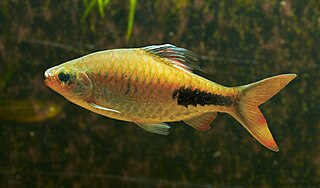
Pethia stoliczkana is a fresh water tropical cyprinid fish native to the upper Mekong, Salwen, Irrawaddy, Meklong and upper Charo Phraya basins in the countries of Nepal, India, Pakistan, Myanmar, Bangladesh, Laos, Thailand, China and Sri Lanka.

Barbodes dunckeri, the bigspot barb or clown barb, is a species of cyprinid fish endemic to the Malay Peninsula where it inhabits clear streams and acidic swamps. This species can also be found in the aquarium trade. It was described by Ernst Ahl in 1929, but was first recognized as a distinct species by Georg Duncker in 1905.
The dash-dot barb is a species of cyprinid fish.
The Jackson's barb is a species of cyprinid fish.
Lortet's barbel is a species of ray-finned fish in the family Cyprinidae. It is only found in the lower course of Orontes River in Syria and Turkey, which were poisoned and nearly dried in 1989 and changed the lake from being abundant to completely fishless. Aside from being extinct in Lake Amik, nothing else is known about the fish.
Luciobarbus magniatlantis, the Tensift riffle barbel, is a species in the family Cyprinidae. It is native to the Tensift River catchment of the Atlas Mountains of Morocco. However, it has been extirpated from the Rheraya River in the middle of its range, which has led to two isolated sub-populations.
The Pellegrin's barb is a species of cyprinid fish.

Labeo dussumieri is fish in genus Labeo known to occur in west-flowing rivers of the Western Ghats. Earlier Sri Lankan population was considered as the same species as L. dussumieri, recent phylogenetic and physiological differences suggest that Sri Lankan population is a distinct species, Labeo heladiva..

The Dharna barb is a species of ray-finned fish in the genus Puntius. It is endemic to India.
Puntius kamalika, Sri Lanka Kamalika’s barb, is a species of cyprinid fish in the genus Puntius. It is found in Sri Lanka.
Enteromius baudoni is a species of tropical cyprinid freshwater fish from Central and Western Africa. It is found in western Africa, in the river basins of the Chad Basin, the Volta basin, the Niger River basin, the Gambia River basin, the Senegal River basin, the Sassandra River basin, and the Bandama River basin. In central Africa, it is found in the Ubangui River ecosystem. It typically inhabits tropical freshwater ecosystems between 24 and 26 °C. It was originally described by Belgian-British zoologist George Albert Boulenger as Barbus baudoni in 1918, and the holotype, collected from Bangui, Central African Republic, is stored at the Muséum national d'Histoire naturelle in Paris. The species was originally classified in the Barbus genus, but was reclassified as belonging to the Enteromius genus in 2015 after examining extensive taxon, geographical, and genomic sampling of the species in the family Cyprinidae.
Enteromius brichardi is a species of cyprinid fish native to the Republic of the Congo and Gabon. This species can reach a length of 8 centimetres (3.1 in) TL.
Enteromius guirali is a species of cyprinid fish. It is endemic to Central Africa and occurs in Cameroon, Gabon, and the Republic of the Congo. It is a benthopelagic freshwater species that grows to 15.5 cm (6.1 in) total length.
The butterfly barb is a species of cyprinid fish in the genus Enteromius.
The gillbar barb is a species of cyprinid fish in the genus Enteromius from Angola and the Democratic Republic of Congo.

The false osman is an Asian cyprinid freshwater fish living in the highlands of Afghanistan, southwestern China, Iran, northern India, Kyrgyzstan, Pakistan and Tajikistan. Young individuals and small adults live in shallow streams and pools, while large adults inhabit the main river and lakes. It grows to 34 cm (13 in) in total length.

Osteobrama feae is a species of ray-finned fish in the genus Osteobrama which is found in the Indian state of Manipur and in Myanmar, being common throughout its range. It grows to 15 cm in length and is of minor fisheries interest. This species has 65 lateral line scales and a very deep laterally compressed body which is bright silvery in colour becoming a more olive shade on the back. It has a rounded snout with a pair of mandibular barbels and a pair of maxillary barbels. The specific name honours the collector of the type, the Italian zoologist Leonardo Fea (1852-1903).

Dawkinsia is a genus of cyprinid fishes from freshwater in South India and Sri Lanka. It was split off from genus Puntius in 2012.
Puntius khohi is a species of fish in the family Cyprinidae in Puntius genus. The species was discovered in 2004, named and described by Dobriyal, R. Singh, Uniyal, H. K. Joshi, Phurailatpam & Bisht, of Gharwhal University in Uttaranchal, India in 2004. The study and paper on Puntius khohi was published in the Journal of the Inland Fish Society the same year (2004). It was collected from a stream called "Sil Gad" which originates from the western slopes of Kalondanda southeast of Lansdowne in the foothills of the Himalayas. The specific name khohi refers to the river in which the Sil Gad stream joins.
Schizopygopsis waddellii is a species of cyprinid fish endemic to Tibet.








